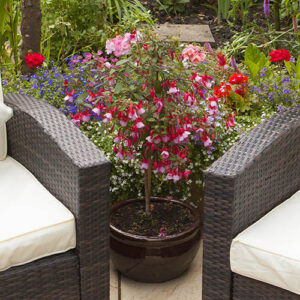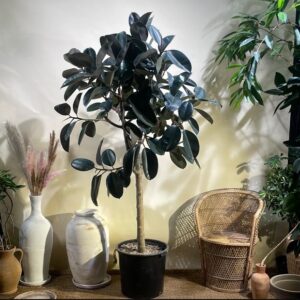Description
Umbrella Tree (Schefflera arboricola) – 1 Yr Old Seedling
Overview
The Umbrella Tree (Schefflera arboricola) is a charming, compact houseplant known for its glossy, dark green, umbrella-shaped leaves. This slow-growing tree is perfect for small to medium-sized indoor spaces and is easy to care for, making it an excellent choice for both novice and experienced plant enthusiasts. With its striking appearance, the Umbrella Tree adds a touch of elegance and greenery to any room, creating a soothing and vibrant indoor environment.
Native Range
Native to Taiwan and southern China, the Umbrella Tree thrives in tropical climates but adapts well to indoor conditions.
Growth and Form
- Height: Typically grows 6–12 inches annually, reaching up to 3–4 feet indoors at maturity.
- Spread: Can spread 2–3 feet wide at maturity, forming a bushy, compact shape.
- Growth Rate: Slow to moderate growth, ideal for indoor settings.
- Foliage: Glossy, dark green leaves with a unique umbrella-like shape, offering a bold and attractive appearance.
- Bark: Smooth and light-colored on younger plants, becoming slightly rougher as the tree matures.
Ecological Benefits
- Air Purification: Known for its ability to filter indoor air by removing toxins and improving air quality.
- Low Maintenance: Ideal for urban environments, requiring minimal care and space.
Hardiness and Climate Tolerance
- Hardiness Zones: 10–12 (Ideal for indoor climates).
- Temperature Tolerance: Thrives in average indoor temperatures of 60–75°F (16–24°C), but can tolerate temperatures as low as 50°F (10°C) for short periods.
- Humidity: Prefers moderate to high humidity levels, making it suitable for bathrooms or kitchens.
- Light Preferences: Prefers bright, indirect light but can tolerate lower light levels, though its growth may slow.
Planting and Care
- Planting Location: Best placed in bright, indirect light, away from direct sun which can scorch its leaves.
- Watering: Water when the top inch of soil feels dry. Avoid over-watering, as this can lead to root rot.
- Fertilization: Apply a balanced, water-soluble fertilizer every 4-6 weeks during the growing season (spring and summer) for optimal growth.
- Pruning: Minimal pruning is required. Trim leggy growth to maintain a bushy appearance.
Uses
- Ornamental: An attractive addition to indoor spaces, providing a lush, tropical look to any room or office.
- Air Purifier: Helps to improve indoor air quality, making it ideal for living rooms, bedrooms, or workspaces.
Potential Problems
- Overwatering: Can lead to root rot, so ensure the plant has good drainage and avoid waterlogged soil.
- Pests and Diseases: May attract spider mites or scale insects. Regularly inspect for pests and treat as necessary.
- Low Light: Prolonged exposure to low light can cause the plant to become leggy and lose its vibrant appearance.






Reviews
There are no reviews yet.